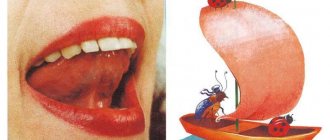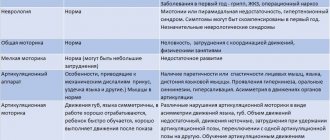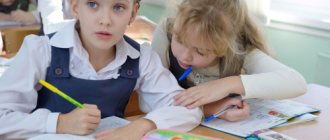Rhinolalia is a speech disorder manifested in distorted pronunciation of sounds associated with defects in the structure and functioning of the speech organs.
Due to the incorrect structure, at the moment of sound formation, the air stream flows in the wrong direction, which leads to distortion of the pronounced sound. This function is provided by the muscles of the palate and the walls of the pharynx, which open or close the passage into the nasal cavity.
In this case, the child’s voice may acquire a nasal quality - it seems as if he is speaking through the nose, or, if the air flows only through the mouth, the nasal sounds [m], [n] and vowels are distorted in speech - in this case they speak of a lack of nasal sound.
The consequence of rhinolalia is not only the distortion of sounds. Written speech is impaired, it is difficult for the child to master vocabulary and grammar, and psychological problems appear.
Types of rhinolalia
There is a widespread classification of rhinolalia into two types based on the reasons for its appearance: organic - when there is a violation of the structure of the speech apparatus, and functional - when there is a violation of the functioning of the speech apparatus.
When rhinolalia occurs, disturbances can be observed in the nasal or oral cavity. Therefore, there are three types of rhinolalia: open, closed and mixed.
The open form is observed when the space between the oral and nasal cavities is constantly open, when air constantly flows through the nose. This results in all spoken sounds having a nasal connotation.
The open form is most common and has three subtypes:
- Organic open rhinolalia occurs due to existing cleft palates, the absence or bifurcation of a small uvula, or a shortened soft palate.
- Organic open rhinolalia manifests itself due to the presence of paresis (incomplete paralysis) and paralysis of the soft palate.
- Functional open rhinolalia.
Closed rhinolalia occurs when there is an obstruction that blocks the space for air flow through the nose. Therefore, the pronunciation of nasal sounds [m], [n], [m], [n] and vowels suffers.
Mixed rhinolalia is a combination of the two types listed above.
If a child is diagnosed with rhinolalia, regardless of the form of manifestation of the disease, parents should immediately seek help from specialists. The most favorable treatment prognosis is given with a functional form. Closed rhinolalia requires more time and effort, which can lead to getting rid of existing speech impediments.
Sometimes they talk about rhinophony. It refers to the excess nasal tone of the voice, which occurs when there is insufficient differentiation between the oral and nasal cavities during the pronunciation of sounds.
Working to overcome the consequences of rhinolalia
Due to the organic origin of the disorder, surgical intervention is often required. A speech therapist is involved in correctional work. Speech therapy correction includes preoperative and postoperative periods. Work in each period is aimed at solving existing problems:
- development and differentiation of oral and nasal breathing,
- development of mobility and accuracy of movements of the organs of articulation,
- education of correct sound pronunciation,
- development of phonemic awareness.
- development of fine motor skills of the fingers,
- An adequate form of speech therapy is massage of the organs of articulation and hands.
Causes
The causes of rhinolalia can be congenital or acquired. Congenital causes of rhinolalia apply to children who have:
- clefts (non-fusion) of the soft and hard palate (“cleft lip”, “cleft palate” and others);
- short soft palate;
- muscle formation above the root of the tongue;
- paralysis or paresis (weakening) of the soft palate, manifested in the difficulty of raising and closing the palate with the back wall of the pharynx;
- flaccidity of articulatory muscles, which occurs in frequently ill children.
Clefts can be through, which involve not only the palate, but also the upper lip. They are one-sided and two-sided. Non-full nonunions are complete, which means they reach the incisor area without affecting the lips. Incomplete clefts are characterized by the fact that non-union occurs in a small area, for example, only in the area of the soft palate.
The acquired form of rhinolalia occurs with mechanical damage to the same areas and the face. In addition, the disease can develop due to tumor growths of the vagus and glossopharyngeal nerves.
For example, a functional open one appears in a person after surgery - removal of adenoids, various tumors and curvatures in the nasopharynx, with curvature of the nasal septum and the formation of polyps in the nasal cavity. In this case, the air practically does not enter the nose or enters there in insufficient quantities.
Closed rhinolalia can occur with adenoids, increased function of the muscles of the soft palate, which leads to isolation of the nasal and oral cavities from each other.
Acquired rhinolalia in a child can appear when a woman in the early stages of pregnancy suffered from viral diseases (influenza, rubella, mumps, dysentery, toxoplasmosis), had endocrine disorders, took certain medications, alcohol and smoked during pregnancy. Some researchers note the hereditary nature of such anomalies (my grandparents had clefts).
Types of cleft palate
Rhinolalia is often a consequence of clefts in the oral cavity, which can be congenital or acquired. Among congenital clefts there are clefts of the face, lip, nose, hard and soft palate. The degree of paresis varies from facial asymmetry to complex combined distortions of parts of the face and complete asymmetry in the eye. Clefts can be unilateral or bilateral. Unilateral are more often observed on the left (70%), more often in men than in women. 69% of men have a cleft lip in combination with a cleft palate, but of the remaining 31%, women are twice as likely to have an isolated cleft palate.
The following types of clefts have been recorded in medicine:
isolated cleft lip (“cleft lip”);
- combination of cleft lip and alveolar process;
- lips, alveolar process and hard palate;
- lips, alveolar process of the hard and soft palate (“cleft palate”);
- damage to the alveolar process and hard palate;
- paresis of the hard and soft palate;
- defect of the soft palate;
- cleft of the small tongue.
Cleft palates are often combined with clefts in the nasal septum, resulting in deformation in the patient - a double nose, a proboscis instead of a nose. The nasal passages may even become clogged.
Acquired clefts occur as a result of tumors, injuries, wounds, and frequent operations. More often they occur in people working in mines, logging sites, and participating in military operations involving explosions.
Symptoms of rhinolalia
The symptoms of the disease depend on its form.
With open rhinolalia, the child’s respiratory functions are impaired. Liquid food entering the cleft palate flows out through the nose, which significantly complicates the feeding process. In addition, the inhaled street air does not warm up to the required temperature, so children suffer from diseases such as otitis media, pneumonia, and bronchitis.
Due to open rhinolalia, children experience different types of developmental delays. For example, such a child begins to speak his first words late - usually after two years. Also, children have a pronounced nasal voice, making it difficult to pronounce sounds. Due to the fact that the root of the tongue is active during conversation, and not the tip, children pronounce most sounds deafly.
Closed rhinolalia is accompanied by rather unpleasant symptoms - mucus, formed in the upper respiratory tract, constantly flows down the back wall of the throat. Colds in this case rarely occur without snot, and the child has a chronic runny nose. Speech disturbances are also present. For example, a child pronounces the sound [b], but comes out [m].
According to many experts, speech defects lead to the development of asthenic syndrome and to some extent affect the child’s psyche; such children become withdrawn and have difficulty making contact.
- Such children are characterized by incorrect pronunciation of most vowels and consonants, their speech is slurred and inexpressive;
- Their voice is quiet, the timbre is dull and unnatural;
- If a child tries to carefully pronounce sounds, he begins to involuntarily grimace;
- At primary school age, such children always have problems with writing and reading.
Articulation exercises
To correct articulation disorders caused by rhinolalia, special exercises are needed:
- “Snake or spade” - you need to learn to stick out your tongue with a pointed tip, and then widely flattened. The next stage is to alternate between “snake” and “shovel”.
- “Bend the back” - the tip of the tongue rests on the lower gums, and the back of the tongue curves up and down.
- “Inflate and deflate” - the cheeks need to be inflated and deflated, pulling them between the teeth. As an option, learn to inflate not both cheeks at once, but alternately. An adult can help deflate the puffy cheek by lightly touching it with a finger.
- “Rinse your teeth” - imitate rinsing your teeth without water (the air should press on your lips).
- “Elephant exercise” - the child must learn to hold his lips closed and extended forward with his “proboscis”, and then move it left and right and even rotate it.
Diagnosis of the disorder
As you can see, the symptoms of rhinolalia strongly overlap with many known diseases. Making a diagnosis is not as difficult as determining the type of disorder. To accurately diagnose the species, you need to consult a specialist. Examination of patients is carried out by various specialists in the field of medicine:
- maxillofacial surgeon;
- otolaryngologist;
- neurologist;
- orthodontist;
- speech therapist;
- orthopedist;
- psychologist.
Research methods depend on the form of rhinolalia. When identifying different types of rhinolalia, special attention is paid to x-rays of the nasopharynx.
The sooner a child is diagnosed with rhinolalia, the sooner treatment can begin. Correcting a neglected form is much more difficult.
During an examination by a speech therapist, a specialist assesses the structure of the articulatory apparatus, the pronunciation of sounds, the understanding and use of words, and the presence of agrammatisms in speech.
Rhinolalia (its open form) is diagnosed based on Gutzman's research, when when pronouncing the vowel sounds [a] and [i], the child alternately begins to close or open the nasal passages. In school-age children, the specialist also examines the processes of writing and reading, which clearly indicate the presence and level of the problem.
Exercises to develop phonemic awareness
- "Who is there?" - the child is asked to close his eyes and recognize musical instruments, sounding toys, and people’s voices by ear. Important: he must know all these sounds well before.
- “Repeat” - the teacher invites the child to repeat after him a set of identical syllables with the emphasis on the first vowel (mA-ma-ma), then on the second (ma-ma-ma) and on the third.
- “Find the mistake” - children love to “correct” adults, so this game is usually popular. The teacher reads the text, and the child must “convict” the author of the mistake. For example: Our Mishka has a big chip (bump) on his forehead.
Classes do not include all exercises at the same time. The speech therapist selects the necessary ones depending on the specific situation and the child’s readiness.
Publication date: 05/31/2017. Last modified: 05/09/2018.
Correction methods
Treatment of rhinolalia includes a whole range of measures aimed at maximizing the elimination of speech defects.
If a child is diagnosed with congenital rhinolalia, then correction of the disorder begins with the elimination of defects of anatomical origin. From birth, such children begin to be fed using a tube, which is selected taking into account the characteristics of the cleft.
A special prosthesis, an obturator, is also made to close the nonunion. This prosthesis facilitates the processes of eating, breathing and speaking.
Late use of an obturator is less effective, since the child begins to develop incorrect tongue position with age. The obturator changes as the child grows and is used until the moment of surgical intervention, which, unfortunately, cannot be done without.
Maxillofacial disorders are subject to surgical intervention. Nasality with open rhinolalia is treated both before and after surgery.
As a rule, cleft lip surgery is performed at 2–3 months of a child’s life. Operations on the palate are carried out after two years, if the child has lost all his teeth. In weakened children, surgery is postponed to a later date or carried out in several stages.
Surgeries allow you to restore the integrity of the speech apparatus and the proper functioning of the palate.
Correction of rhinolalia
Correction of rhinolalia should have a comprehensive approach. As a rule, congenital anomalies of the structure of the facial skull are subject to surgical correction. Congenital defects are corrected using plastic surgery. Such operations are aimed at restoring the anatomical structure of the organs of the nose and pharynx, as well as eliminating cosmetic defects.
In addition, some patients require surgical interventions to remove nasal polyps, adenoids and other pathological formations that interfere with normal nasal breathing. Correction of the bite and deformations of the upper jaw by an orthodontist is also required. Physiotherapy, special speech therapy sessions, and psychotherapy also play a significant role in the treatment process.
Rhinolalia is a complex and very diverse disease, the successful treatment of which requires the participation of specialists from many areas of modern medicine. In particular - speech therapy, dental surgery, otolaryngology, orthodontics, psychology.
Why should you contact NeuroSpectrum?
Does your child have obvious or subtle speech problems? Contact the NeuroSpectrum Center for Pediatric Speech Neurology and Rehabilitation - we have experienced doctors who have the most modern diagnostic and medical equipment at their disposal. In particular, we have extensive experience working with children diagnosed with open rhinolalia - the mechanism of the disorder, symptoms, concomitant diseases and many other factors are taken into account when drawing up an individual treatment plan.
Our Center’s specialists will talk about the prevention of open rhinolalia and will carry out all the necessary examinations and medical procedures.
Correction of sounds begins with those most accessible to the child. The choice of method and exercises is determined strictly individually. However, severe organic defects may prevent the achievement of ideal articulation. Cicatricial changes in the lip limit its mobility: open bite, progenia, prognathia, dentition disorders in the anterior part of the upper jaw, constant wearing of an orthodontic apparatus complicates the production of labiolabial and anterior lingual sounds. Significant scar changes flatten the palatine vault and limit mouth opening.
Leakage of air into the nose during shortening and fistula of the palate leads to irritation of pressure, and the strength of sounds is weakened.
In addition to this difficulty, which is characteristic of the entire group of plosives, the correction of sounds p, p , , b can be complicated by a sedentary upper lip, tightened with scars; t, t , , d, d , - alveolar cleft and dentition disorders; k, k , , g, g , - pronounced shortening of the palate and fistulas at the border of the hard and soft palate.
Placing the bilabial p is possible in various ways. So, if there is a directed air stream, the child is asked to pat his lips during a soft, quiet blow. At the same time, a whispered pa-pa-pa . Moisturizing the lips creates a slight stickiness and makes it easier to close.
As an initial technique, you can use “spitting” with your lips if the child has already learned to do this exercise with his tongue sticking out.
If you have a long, moving palate, it is recommended to puff out your cheeks and slap your palms on them so that the air from your mouth suddenly breaks through your closed lips.
It is impossible to inflate the cheeks with velopharyngeal non-closure. In this case, they pinch the wings of the nose with their fingers to reduce air leakage, and learn to “spit” lightly. Then they do this exercise with the wings of the nose open.
It 's easy to get spitting between teeth To do this, you need to smile to expose your teeth and spit, sticking out the tip of your tongue slightly.
The sound t can be caused from p . pa-pa-pa several times in a row , placing a wide tongue on the lower lip. Then they reproduce the same syllables while smiling in order to disconnect the lips from articulation.
The sound k in rhinolalia is either absent or replaced by a pharyngeal sound. It is corrected by moving the front part of the back of the tongue into the depths of the oral cavity with a spatula while pronouncing the syllables ta-ta-ta .
As the tongue moves, the syllable ta becomes cha , then kya , and finally ka .
According to A. G. Ippolitova, the easiest way to produce the f . To do this, the patient, following instructions or with mechanical assistance, brings the lower lip closer to the upper teeth and blows on it.
Sound is most often corrected in the traditional way. They are taught to blow on cotton wool, to blow with a wide tongue stuck between the lips, to blow on the tongue between the teeth, to blow on the tongue moved towards the lower incisors.
The sound ts is easily obtained from the fusion of the sounds t and s .
When making the sound sh, a lot of time is spent learning to raise the tongue in the shape of a “cup”.
To correct the sound с, it is enough to pronounce с, rounding your lips and pulling back the tip of your tongue.
The affricate q is placed from t , or from the merger of t , and sh . Its introduction into syllables begins with closed ones.
The sound x usually does not cause any difficulties.
The sound j is obtained by merging the vowel with and in words, for example: iakor instead of “anchor”. But the absence of this phoneme in rhinolalia is observed only in children under 5 years of age.
The sound l , especially its soft version, turns out to be preserved more often than other consonants.
The vibrating sound p is quite rarely possible to produce in case of insufficient velopharyngeal closure. In these cases, the directed air jet cannot achieve the proper force to vibrate the tip of the tongue.
The obstructive nasal sounds m , n can also be disrupted with rhinolalia.
Usually they begin to correct sound pronunciation with dull sounds.








